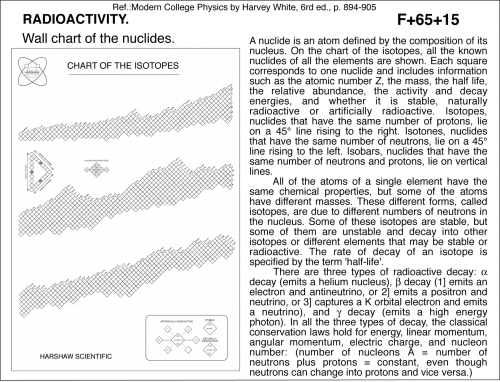Wall chart of the nuclides.
Primary tabs
Wall chart of the nuclides. A nuclide is an atom defined by the composition of its nucleus. On the chart of the isotopes, all the known nuclides of all the elements are shown. Each square corresponds to one nuclide and includes information such as the atomic number Z, the mass, the half life, the relative abundance, the activity and decay energies, and whether it is stable, naturally radioactive or artificially radioactive. Isotopes, nuclides that have the same number of protons, lie on a 45 deg line rising to the right. Isotones, nuclides that have the same number of neutrons, lie on a 45 deg line rising to the left. Isobars, nuclides that have the same number of neutrons and protons, lie on vertical lines. All of the atoms of a single element have the same chemical properties, but some of the atoms have different masses. These different forms, called isotopes, are due to different numbers of neutrons in the nucleus. Some of these isotopes are stable, but some of them are unstable and decay into other isotopes or different elements that may be stable or radioactive. The rate of decay of an isotope is specified by the term 'half-life'. There are three types of radioactive decay: _ decay (emits a helium nucleus), _ decay (1] emits an electron and antineutrino, or 2] emits a positron and neutrino, or 3] captures a K orbital electron and emits a neutrino), and _ decay (emits a high energy photon). In all the three types of decay, the classical conservation laws hold for energy, linear momentum, angular momentum, electric charge, and nucleon number: (number of nucleons A = number of neutrons plus protons = constant, even though neutrons can change into protons and vice versa.) Ref.:Modern College Physics by Harvey White, 6rd ed., p. 894-905
UCB Index:
F+65+15
UCB Taxonomy:
Popularity:
- Log in to post comments

